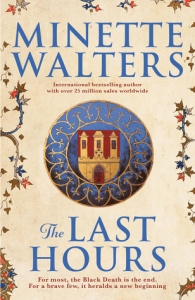 About the Book
About the Book
June, 1348: the Black Death enters England through the port of Melcombe in the county of Dorsetshire. Unprepared for the virulence of the disease, and the speed with which it spreads, the people of the county start to die in their thousands. In the estate of Develish, Lady Anne takes control of her people’s future – including the lives of two hundred bonded serfs. Strong, compassionate and resourceful, Lady Anne chooses a bastard slave, Thaddeus Thurkell, to act as her steward. Together, they decide to quarantine Develish by bringing the serfs inside the walls. With this sudden overturning of the accepted social order, where serfs exist only to serve their lords, conflicts soon arise. Ignorant of what is happening in the world outside, they wrestle with themselves, with God and with the terrible uncertainty of their futures. Lady Anne’s people fear starvation but they fear the pestilence more. Who amongst them has the courage to leave the security of the walls? And how safe is anyone in Develish when a dreadful event threatens the uneasy status quo…?
Format: eBook (560 pp.), hardcover (550 pp.) Publisher: Allen & Unwin UK
Published: 2nd November 2017 Genre: Historical Fiction
Pre-order/Purchase Links*
Amazon.co.uk ǀ Amazon.com
*links provided for convenience, not as part of any affiliate programme
Find The Last Hours on Goodreads
My Review
Minette Walter’s first novel in a decade marks a significant change in direction in terms of genre. Click here to read Minette’s interview with The Guardian about her move from writing psychological thrillers to historical fiction. This is the first book I’ve read by Minette Walters and I came to it with high expectations knowing her reputation as a storyteller and because the period setting and subject matter intrigued me.
The author does a good job of conveying the panic of the villagers as the plague takes hold and their ignorance of its source and method of transmission. Given the paucity of medical knowledge at the time, it’s easy to understand why many of them believe it to be a punishment sent by God. However Lady Anne’s religious beliefs and humanitarian instincts lead her to reject the idea of a merciless God raining down pain and suffering indiscriminately. Luckily for the villagers, she also possesses some quite modern notions of hygiene practices. That and her decision to have the villagers seek refuge behind the moat and walls of the manor house, cutting themselves off from the outside world, offer them the possibility of survival.
Eventually the need for food and news of the outside world means some of them must venture outside the safety of the manor house. Their experiences take up a large proportion of the second half of the book.
The book is clearly the product of extensive research and there were many things I found interesting. For instance, appreciating how little ordinary people travelled in those days and their lack of knowledge of what lay beyond even their own demesne. I hadn’t realised either that, at that time, cats were rare, unfamiliar creatures and forbidden by the Church as instruments of the Devil.
Most interestingly, the author explores the social impact of the plague. Not only that it was no respecter of position in society, targeting serf and noble alike, but that it created a situation where, in its aftermath, lords would be dependent on their serfs to restore the wealth of their lands. If you like, the law of supply in demand would come into effect, with the few serfs left alive able to bargain with landowners for their freedom in return for their valuable labour. Furthermore, the needs of survival thrust ordinary people into positions of unaccustomed authority or forced them to take responsibility for decision-making and organisation where they would previously have been used to taking direction.
I found a lot to enjoy in this book and I know many reviewers have been fulsome in their praise. However, I have to say that I did find it over long and rather slow, especially the second half which dragged for me. I was also taken by surprise and felt slightly let down by the nature of the ending.
I received an advance reader copy courtesy of NetGalley and publishers Allen & Unwin UK in return for an honest and unbiased review.
In three words: Well-researched, detailed, dramatic
Try something similar…The Outcasts of Time by Ian Mortimer (click here to read my review)
 About the Author
About the Author
Minette Walters is a British mystery writer. After studying at Trevelyan College, University of Durham, she began writing in 1987 with The Ice House, which was published in 1992. She followed this with The Sculptress (1993), which received the 1994 Edgar Award for Best Novel. She has been published in 35 countries and won many awards. The Sculptress has been adapted for television in a BBC series starring Pauline Quirke. Her novels The Ice House, The Echo, The Dark Room, and The Scold’s Bridle have also been adapted by the BBC.
Connect with Minette

